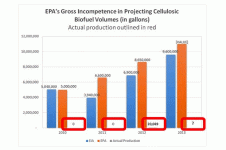that article was updated in 2008. Boy that is really current. Find something related that is more like in the last year?
I have been using 10% ethanol in everything that runs on gasoline from my chain saw to my portable generators to my vehicles since the late 70's / early 80's. Even ran a 30% blend in a 2002 Chevy Cavalier (non flex fuel) that the wife had and never had an issue. I have NEVER had a fuel related problem. Never added anything to the mix either. There are some things that get attributed to being caused by ethanol like the manufacturer used poor quality components, owner did not do regular maintenance issues like changing fuel filters, etc. Phase separation and such are over blown issues with no real merit. Some even claim that the standard aluminum tanker trucks need special tanks to haul ethanol. As a person who had tanked fuel, I can tell you that is absolute rubbish. The same aluminum tanker hauls, straight ethanol, blended, dino diesel, and bio diesel.
Anecdotal stories make for nice copy in the newsroom, but hardly pass for scientific analysis. Groups like the Technology and Maintenance Council, who is the de facto industry standard regarding fleet vehicle maintenance from small vehicles up thru class 8 trucks, has shown no real problem in their testing of ethanol fuels in vehicles which were built using industry standard components. Only when substandard components were used or improper maintenance performed did issues crop up.
But I am confident that I did not make a dent in anyone's perception who has a conspiracy theory type of mindset.
How's This?
The D.C. Circuit chastised the Environmental Protection Agency for favoring the biofuel industry instead of objectively projecting cellulosic ethanol production. You would think that the EPA would have been slightly cowed by the court, but they were not. Less than one week after the ruling, the agency has released new projections that are even more out of touch with reality than the projection that the court struck down. Sadly, the EPA's decision has consequences and in this case, it means higher gasoline prices at the pump.
In 2007, Congress and President Bush passed a law mandating fantastically large volumes of cellulosic ethanol. For example, for 2013 the law requires refiners to buy 1 billion gallons of cellulosic ethanol. But Congress understood that reality might not match their expectations and authorized the EPA to annually consult with the Energy Information Administration to project the amount of cellulosic ethanol that will be produced the next year. The EPA's projection would then be the mandated amount of cellulosic ethanol.
The EPA's projections have been out of whack with reality and because oil refineries are required to buy this phantom fuel or purchase credit (in effect a tax), the refiners took the EPA to court for skewing its projections in favor of cellulosic ethanol producers to the detriment of refineries and gasoline-buying Americans.
It is easy to see why the refiners were frustrated with the EPA's projections. In 2010, EPA projected that 5,000,000 gallons of ethanol would be produced, but not a drop was sold. In 2011, the EPA ignored the lack production.
In 2012, after two years of zero cellulosic ethanol production, the EPA's projection didn't return to reality, but further increased. At this point it became obvious that the EPA's projection was not an objective forecast, but an attempt to create a market for cellulosic ethanol. The refiners took agency to court and the court agreed.
The chart below shows the Energy Information Administration's forecast, the EPA's forecast, and actual cellulosic ethanol production. In 2012, it turns out that there was some cellulosic ethanol production?0,069 gallons. This was far short of the 8.65 million gallons the EPA mandated.
After being reprimanded by the court, one would think that the EPA's projections would be a bit more reasonable. But that would be incorrect. Less than a week after the court instructed the agency to be objective, the EPA released a new forecast that projects a whopping 14 million gallons of cellulosic ethanol to be produced in 2013.
The EPA argues that more companies are building cellulosic ethanol plants and that more of these plants will produce ethanol this year. This may be true, but it was also true in 2010, 2011, and 2012. In those years the EPA projected that 20,250,000 gallons would be produced, but only 20,069 gallons were actually produced. In fact, the closest the EPA has come to accurately project cellulosic ethanol production was in 2010勇PA's first and lowest projection. In its subsequent forecasts, the EPA apparently learned nothing from history.
